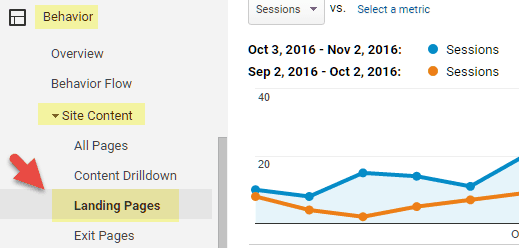The phrase “landing page” has a few different meanings, but in this video we’ll dive into effective Landing Pages for SEO. Along the way, we’ll also discuss landing page design from the perspective of AdWords.It’s absolutely critical to create landing pages for search engine optimization. Let’s get started!
- Watch the Video
- Links and Resources (scroll down below the video)
Watch ‘Landing Pages for SEO and AdWords: C / E / A‘ on YouTube!
The Three Meanings of Landing Pages
In this video, we’re going to focus on the SEO and AdWords meaning of landing pages, but first let’s get a more common definition out of the way. To many, including Google Analytics, “landing page” simply means the first page that a user touches when they “land” on your landing page. In many cases, this will be your home page, and in many others, it may be a blog post. The pattern is:
- Keyword search on Google > Your website page ranks on Google > You get the click > They land on your “home page” / “blog post” (a.k.a. “landing page”) and then they either do your desired action or goal, or not (bounce).
Here’s a screenshot from Google Analytics, showing this first meaning of “landing pages” –
That, however, is NOT the meaning we are interested in here. Similarly, in AdWords, a landing pages is a page that you specifically create for AdWords (more on this in a second). We are interested in a special SEO meaning of landing pages, but keep in mind that there is one meaning (Google Analytics: landing page = any page, that is the FIRST page that they touch) which is NOT what we are talking about, and a second meaning (AdWords: the page you design specifically for AdWords) that is close but not exactly the same as SEO.
What is a Landing Page for SEO?
A landing page for SEO has some specific attributes. First, you create it specifically to “match” a keyword query. For example, if you want to rank on “motorcycle insurance” you’ll create a web page that specifically matches this query. If you take a look at Progressive.com and Geico.com, for example, you’ll see that they have created pages that “match” very important search queries:
motorcycle insurance, matching: this page on Progressive, and this page on Geico.
RV insurance, matching: this page on Progressive, and this page on Geico.
In fact, you can visit this page on Progressive and see that they have made cookie-cutter pages of all their main product offerings / search queries, including my personal favorite, golf cart insurance, here. Let’s dive into this Golf Insurance landing page, and “reverse engineer” its SEO.
Attributes of Landing Pages: SEO Optimization
Landing pages for the purposes of SEO share some common attributes (Right Click > View Source to see their HTML source code) –
- Keywords. They reflect a targeted keyword as in “golf cart insurance” and related terms such as company, rates, coverage, comprehensive, collission, etc. A little keyword research has been done, in the background, to identify the core keyword phrase (“golf cart insurance”) plus helpers such as quote / rate / company.
- Meta Tags.
- The TITLE tag has been optimized, as in <title>Progressive Golf Cart Insurance – Insure Your Golf Cart With Golf Cart Insurance From Progressive</title>
- The META description tag has been optimized as in <meta name=”description” content=”Protect your golf cart with golf cart insurance. Your homeowners policy might not cover your golf cart if you ride off your own property, so specialized golf cart insurance is important. Choose Progressive golf cart insurance for gas or electric golf carts. We provide coverage for virtually any noncommercial purpose and location.”>.
- Other Tags. Where possible, keywords have been “woven” into other key tags such as the header, IMAGE alt, and cross-links between pages. For example, this page has an H1 which is: <h1>Golf Cart Insurance</h1>
- Visible Content. The keywords and related phrases have been woven into the visible content, in such as way as to increase the keyword density yet not be so dense as to get in the way of human readers, nor generate a Google Panda penalty for poorly written content. Take a look at the existing page on Golf Cart Insurance, here, and do a CTRL+F for “golf cart” to see how densely written the content is to regurgitate the target phrase to Google.
- Cross Links To/From Other Pages. Finally, the major landing pages should be “one click” from the home page, and hopefully included as well in the Keyword Footer / navigation. Secondary landing pages should at least be included in the sitemap / navigation. In this way, “motorcycle insurance” is “one click” from the Progressive Home page AND “one click” in the keyword footer (vs. Golf Cart Insurance – which, not as important / not as competitive – is onlyin the sitemap / linked to from the Gateway page of all products).
For AdWords, this type of optimization is not quite so necessary. However, by SEO-optimizing your AdWords landing pages, you will increase the Quality Score on AdWords, thereby decreasing your Cost Per Click and saving you money!
C / E / A Model of Landing Page Optimization
Once you’ve identified your target keyword queries, and SEO-optimized your landing pages, you want to think about the “human element,” namely what happens when a human clicks FROM Google and LANDS on your landing page? Here, the SEO and AdWords view of landing pages is essentially the same: you want to use the C/onfirm, E/ngage, A/ction or CEA model of landing page design. Looking top to bottom, left to right, optimize for the human experience as follows:
C/onfirm. They should see a picture that represents the search query and some BIG FONT TYPE that also regurgitates what they searched for. This is to CONFIRM that they have landing IN THE RIGHT PLACE, so that they do NOT click back.
E/ngage. They should see some “trust indicators” such as good-looking photos, qualifications, and verbiage that engages them, explaining that your company / product /service is AWESOME (!) and worth trusting, and taking the next step.
A/ction. They should see a desired action, such as a purchase or registration – hopefully for something FREE like a FREE consultation, FREE quote, or FREE eBook. This is to move them “up” your sale ladder or “down” your sale funnel (if you use that terminology).
Revisit the landing pages, above, and notice how they use the C / E / A structure. Progressive and Geico do a fantastic job with their SEO and AdWords, and reverse engineering them is a great way to learn. “Imitation is the highest form of flattery.” Next do other competitive searches such as “Medical Malpractice Attorney,” or “Reverse Mortgage Calculator” and notice how the winners on those Google searches also use this tactic. And do searches in your industry as well. Finally – for extra credit – realize that in some situations, the home pages will outrank the landing pages, but landing pages are still often there “in the background” helping out on the SEO.
Now, get out there and go build and optimize your own landing pages. What are you waiting for?



